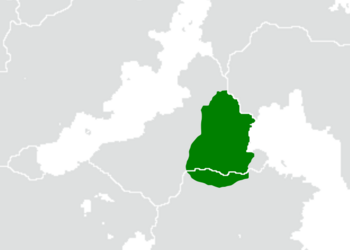Kingdom of the Drev: Difference between revisions
No edit summary |
No edit summary |
||
| Line 14: | Line 14: | ||
|p1 = | |p1 = | ||
|s1 = Sevromark | |s1 = Sevromark | ||
|s2 = | |s2 = Duchy of Yugstran | ||
|event_pre = | |event_pre = | ||
|date_pre = | |date_pre = | ||
| Line 27: | Line 27: | ||
|image_flag = Flag_of_Hungary_(11th-12th_century).svg | |image_flag = Flag_of_Hungary_(11th-12th_century).svg | ||
|flag_alt = | |flag_alt = | ||
|flag = Royal Standard of the kingdom after its convertion to | |flag = Royal Standard of the kingdom after its convertion to [[Aletheic Church|Nazarism]] | ||
|flag_type = <!-- Displayed text for link under flag. Default "Flag" --> | |flag_type = <!-- Displayed text for link under flag. Default "Flag" --> | ||
|image_coat = | |image_coat = | ||
Latest revision as of 11:48, 13 August 2022
Kingdom of the Drev Drevstag | |||||||||
|---|---|---|---|---|---|---|---|---|---|
| 206 years | |||||||||
|
Flag | |||||||||
 Kingdom of the Drev at its greatest extent | |||||||||
| Religion | Aletheic Nazarism | ||||||||
| Government | Monarchy | ||||||||
| Drev Korran | |||||||||
• 816 - 829 | Garza I | ||||||||
• 1014 - 1022 (last) | Worsak V | ||||||||
| History | |||||||||
• Lush settlement | 816 | ||||||||
• Ikonkivoyra | 1022 | ||||||||
| |||||||||
The Kingdom of the Drev was one of the two Lush kingdoms that came from the partition of king Gersa I retinues. It took its name from the Drev river around which the kingdom was centered.
In 811, Gerza I died. Two of his sons had survived to adulthood and shared their father's inheritance. The second born, Worsak, received no land but enough men and cattles to survive. But rather than continue his people's migration, he chose to settle in the Drev river valley. To win the local Ludz communities to his side, he converted to Aletheic Nazarism. It's this act that is considered to mark the birth of the Kingdom of the Drev.
In 1014, the king Worsak IV was murdered because of his Iconoclast sympathies. His weak son, Worsak V, was crowned under the patronage of his first cousin once removed, the Duke Havar of Vizstran. Havar was the leader of the Iconodulist faction, and he led campaigns after campaigns of repression against the Iconoclast movement. He died in 1020 and was succeeded in his position of strongman by his son, who was murdered in broad daylight the same year. Karro, Magrave of Sevromark, gathered a powerful Iconoclast army and marched on the capital, where he forced the king to appoint him as the new Mayor of the Palace. Two years later, Worsak V died without an heir. Rather than claim the throne for himself, Karro elevated his March into a Kingdom. Since the leader of the Iconodulist remnants refused to take the mantle of King of the Drev, preferring to elevate his lands to a Grand-Duchy, it was the official end of the Kingdom.
Government
The Monarch
The Drev Korran had limited powers that made him a "first among equals" or the "fair judge" of his land rather than an absolute ruler. He couldn't raise taxes, and there was no institutions in place to let the King directly reach his subjects, leaving the landowning nobility to play the role of intermediary bodies between the monarch and his people. With the lack of taxes, the king and his court was entirely dependent on the revenues from his own lands. The fragmentation of the royal domain among the king's children meant that the crown's revenues were always dwindling. Dynastic strategies, investment in the infrastructures, intensification of the agriculture, and other attempt to acquire more lands slowed down the process, but did not stop it. Especially once the landowning aristocracy of the northern and southern borders started to expand outward through conquests and raids, something the Monarchy couldn't do. Ultimately, the crown became politically dependent on this high nobility and on any strongman that emerged. A process that led to the dislocation of the kingdom.
The Mergrovet
The Mergrovet or "Mayor of the Palace" was originally one of the King's courtier who was in charge of the correct management of his master's material wealth, without any political power. With time it became the equivalent of a Chancellor or of a Prime Minister, de facto head of the government. During the early days of the Ikonkivoyra, both the Iconodulists and Iconoclasts fought over the position as it was synonymous of taking over the kingdom. The last two Mergrovets, Duke Havar of VIzstran and Marquis Karro, are both perfect examples of the political evolutions of the late Drev kingdom.
The Clergy
Despite the hegemony of the Lushs over land ownership, Drev's early priesthood was made entirely off Ludz. This allowed the old aristocratic families to secure a place for themselves in the higher political spheres, serving as bishops, deacons, and scribes. Religion during the early years of the kingdom was a tool of integration of the various elites and the monarchy kept close ties with the Aletheic Church as a way to profit from their dense network of clergymen and natural positions as community leaders. The schism between the Iconoclasts and the Iconodulists during the late period of the kingdom was a devastating blow to the unity of the kingdom, reducing the legitimacy of both the Church and of the Crown while aggravating the conflicts inside the nobility.
List of kings
In total, there were nine kings of the Drev who ruled for 206 years.